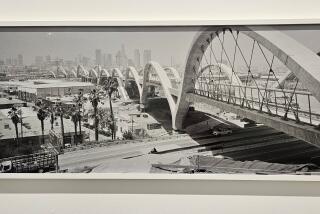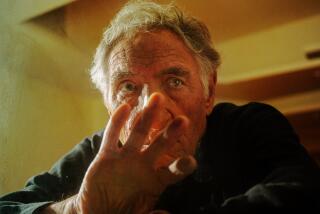Sides Square Off for Mapplethorpe Photo Trial : Artwork: The obscenity case goes to court this week. Legal scholars, the world of culture and foes of pornography will be watching it closely.
- Share via
CINCINNATI — Seven months ago, when most folks here thought a Mapplethorpe more than likely was a type of rare songbird, a group of men and women who call themselves Citizens for Community Values somehow procured copies of Robert Mapplethorpe photographs that were scheduled to be displayed at a downtown arts center.
Yes, they agreed, this was smut.
Having reached this decision, though, the group agonized awhile.
“It bothered us a lot,” said Phil Burress, spokesman for the organization. “We spent a lot of time talking about this--what should we do.”
The late Robert Mapplethorpe, after all, was not your average scuzzy, no-name pornographer--the type the citizens group and others like it have been chasing out of Cincinnati a good 20 years. He was a respected artist. His works hung in museums. Going after him and Cincinnati’s Contemporary Arts Center, which was bringing his photographs to town, would not be quite the same as getting stores to stop selling Hustler magazine.
But in the end, the group made its decision: “Obscenity is obscenity, no matter where it’s at,” is how group spokesman Burress put it.
As a result of that decision, and the events it set into motion, the arts center and its director will stand trial this week on two misdemeanor counts each of pandering obscenity and using children in nudity-oriented material. It is the first time a major museum or gallery has stood trial on an obscenity charge, legal scholars say, and the case is being watched closely by art professionals and anti-pornography groups across the country.
Mapplethorpe died on March 9, 1989. But his sometimes shocking photographs depicting graphic sadomasochistic acts and homosexual poses have helped kindle a national debate on freedom of expression.
The uproar over his work began last year when the Corcoran Gallery in Washington, D.C., cancelled a showing of his photographs because of opposition lead by Sen. Jesse Helms (R-N.C.).
By the time that happened, the Contemporary Arts Center already had made arrangements to bring the show to this conservative Midwest city.
“When I saw the Mapplethorpe show in New York I thought it was an absolutely stunning exhibit,” said Dennis Barrie, director of the arts center. “It fit into our mission, which has been to show challenging work for 51 years.”
Barrie, who has been director of the center for six years, said that until the Washington controversy began he never dreamed that Mapplethorpe’s photographs would cause a stir here.
“I didn’t think this was that extraordinary,” he said. “Mapplethorpe is not the first artist to deal with homosexuality and he’s not the first artist to have fairly graphic photographs . . . . We and other places in the city have shown this kind of work.”
“Either he was very ignorant of our community standards,” said Burress of Barrie, “or he deliberately was trying to challenge us. He’s paying the price, one way or the other.
“We’re not trying to restrict anybody’s artistic ability, if this is what they call artistic ability,” Burress added. “Take pictures, do what you want, but don’t put it on public display . . . . This is where the big problem is.”
Since the controversy in Washington last year, Mapplethorpe’s photographs have toured the country, causing little stir in most cities where they have been exhibited.
In Cincinnati, the Citizens for Community Values launched a campaign of public pressure and letter writing last March. Cincinnati Police Chief Lawrence Whalen and Hamilton County Sheriff Simon Leis, a man whose reputation as a pornography fighter goes back for decades, stated publicly that some of the photographs were in their opinion criminally obscene.
Vice officers raided the arts center on April 7, the day the exhibit opened to the public, temporarily shutting down the show while they took photographs of the exhibit and served indictments. The center quickly got an injunction barring authorities from confiscating works or permanently closing the show.
Since then, arts groups across the country have rallied to the center’s support, and on Monday the Greater Cincinnati Gay and Lesbian Coalition will hold a demonstration outside the courthouse to protest the prosecutions, which they call harassment of homosexuals as well as of the arts community.
Barrie said he believes a “national network” of anti-pornography crusaders is behind the Cincinnati protests and that the local citizens group probably received copies of the Mapplethorpe photographs from cohorts in Washington. Burress won’t say where they got the photographs, but he accused Barrie of arrogance for not agreeing to take the most objectionable pieces out of the show before it opened. “They chose to push the issue,” he said.
Removing pieces from the show was never considered, said Barrie. The center did take the special step of displaying photographs depicting sadomasochistic poses in a separate room from the other work and allowing only people who were 18 or older into the room.
Already, before the trial begins, the arts center has lost two important decisions before Hamilton County Municipal Court Judge David J. Albanese.
In the most recent one, earlier this month, Albanese ruled that the five photographs a grand jury found to be obscene will be considered individually rather than as part of the larger 175-piece exhibition, “Robert Mapplethorpe: The Perfect Moment,” which was displayed in Cincinnati for two months last spring.
The exhibition included many still lifes and portraits in addition to several photographs depicting sadomasochistic acts.
The U.S. Supreme Court, in its Miller vs. California decision in 1973, ruled that a work of art must be judged “as a whole” when determining whether it is obscene. Attorneys for the center had argued that the entire exhibition must be judged, but Albanese ruled that each photograph “exists as a single work of art.”
The ruling means the center and Barrie may be found guilty if a jury finds only one of the photographs to be obscene.
Barrie could face a maximum penalty of a year in jail and a $2,000 fine if he is found guilty. The center could face a fine of up to $10,000.
The other important ruling came in June, when Albanese ruled that the arts center is not a museum as defined by Ohio law. The center’s lawyers had argued that state law allowed museums to display even obscene works for educational and cultural purposes.
Despite testimony which showed that the center is a member of the American Assn. of Museums and is recognized as a museum by art professionals across the country, the judge said it is an art gallery and therefore subject to prosecution under obscenity statutes.
More to Read
The biggest entertainment stories
Get our big stories about Hollywood, film, television, music, arts, culture and more right in your inbox as soon as they publish.
You may occasionally receive promotional content from the Los Angeles Times.










